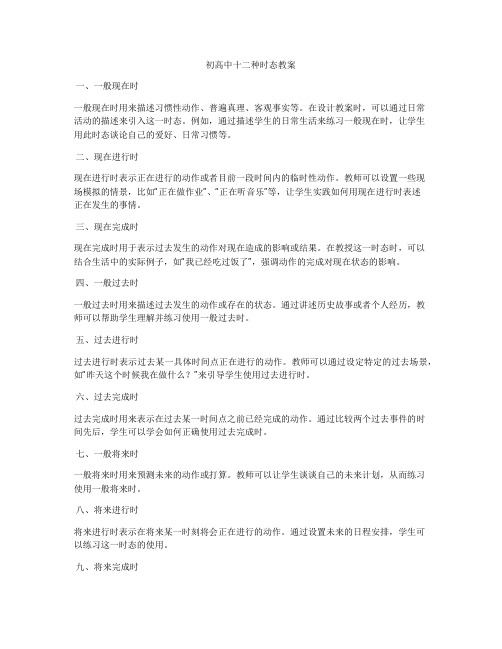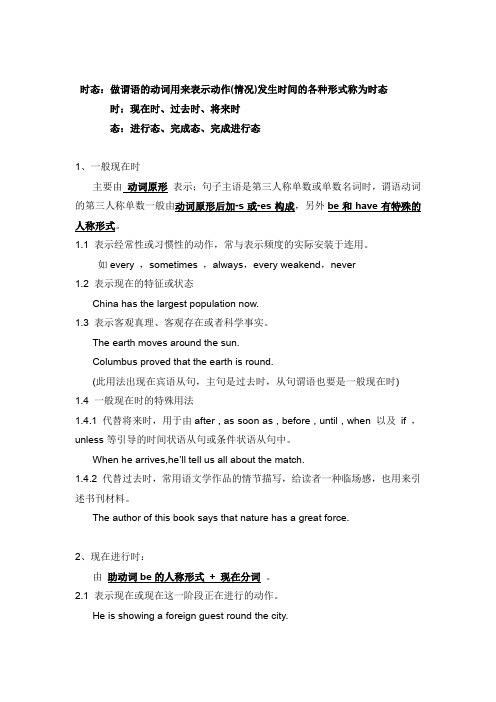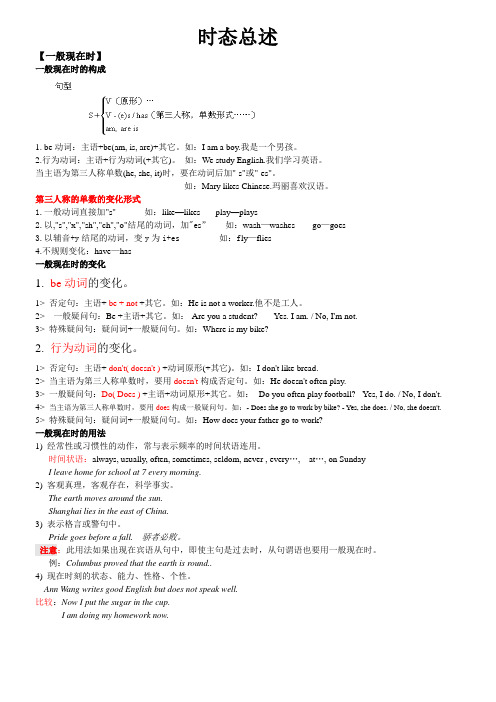[精品]英语十二种时态
英语最基本十二种时态配例句详解

英语最基本十二种时态配例句详解Tense and aspect, although they are two different categories, always appear together. There are six tenses and two aspects in English. With reference to tense and aspect, we can speak about the following structures in practical usage. All English Tenses with Examples!时态和体虽然是两个不同的范畴,但总是同时出现的。
英语有六个时态和两个方面。
关于时态和体,我们可以在实际使用中谈一下以下结构。
全英语时态举例。
(Note: progressive aspect is often called continuous.)(注:进行体通常称为连续体。
)NO. 1、present simple一般现在时Tenses: Present Simple (present tense + common aspect)时态:现在简单(现在时态+共同体)Affirmative肯定句Affirmative: Subject + Base Form of the Verb肯定句:主语+动词的基本形式*note: for 3rd Person Singular (he/ she/ it) add ‘s’ to the base form*注:对于第三人称单数(he/she/it),在基表中添加“s”I/ You/ We/ They work in a bank.我/你/我们/他们在银行工作。
He/ She works in a bank.他/她在银行工作。
Negative否定句Negative: Subject + don’t/ doesn’t + Base Form of the Verb动词:主语+don’t/ doesn’t +动词的基本形式I/ You/ We/ They don’t (do not) work.我/你/我们/他们不工作。
English Grammar:十二种英语时态主被动语法结构总结

时间
形态 语态
一 般
现在
主 He gives me a cup of tea. 被 I am given a cup of tea by him.
ቤተ መጻሕፍቲ ባይዱ
过去
主 He gave me a cup of tea. 被 I was given a cup of tea by him.
将来
主 he will give me a cup of tea. 被 I shall be given a cup of tea.
\ \
he has given me a cup of tea. I have been given a cup of tea by him. he had given me a cup of tea. I had been given a cup of tea by him. he will have given me a cup of tea. I shall have been given a cup of tea by him. [现在完成进行时] have/has + been + 现分
give gave given
进 行
be(am/are/is) + 现分 be(am/are/is) + being + 过分 was/were + 现分 was/were + being + 过分 will be + 现分
\ \ \
完 成
have/has + 过分 have/has + been + 过分 had + 过分 had + been + 过分 will/shall + have + 过分 will/shall + have + been + 过分 [现在完成进行时] have/has + been + 现分 [过去完成进行时] had + been + 现分
十二种时态

• 例如:I studied French when I was a child. • 我小时候学过法语。 • He played the violin. • 他拉过小提琴。 • She worked at the movie theater after school. • 她放学后在电影院工作。 • They never went to school, they always skipped. • 他们总是翘课没有去学校。
十二种时态
一、一般现在时(Simple Present) 二、现在进行时(Present Continuous) 三、一般过去时(Simple Past) 四、过去进行时(Past Continuous) 五、现在完成时(Present Perfect) 六、现在完成进行时(Present Perfect Continuous) 七、过去完成时(Past Perfect) 八、过去完成进行时(Past Perfect Continuous) 九、一般将来时(Simple Future) 十、将来进行时(Future Continuous) 十一、将来完成时(Future Perfect) 十二、将来完成进行时(Future Perfect Continuous)
3.表示单一的持续动作
• 表示一个动作在过去的某个时间开始并延续一段时间后结束,通常与 表示时间的短语 for two years, for five minutes, all day 或all year 等 连用。
• 例如:I lived in Brazil for two years.我在巴西住了2年。 • Shauna studied Japanese for five years.肖娜学了5年日语。 • They sat at the beach all day.他们在沙滩上坐了一整天。 • We talked on the phone for thirty minutes.我们讲了半个小时的电话。
初高中十二种时态教案

初高中十二种时态教案一、一般现在时一般现在时用来描述习惯性动作、普遍真理、客观事实等。
在设计教案时,可以通过日常活动的描述来引入这一时态。
例如,通过描述学生的日常生活来练习一般现在时,让学生用此时态谈论自己的爱好、日常习惯等。
二、现在进行时现在进行时表示正在进行的动作或者目前一段时间内的临时性动作。
教师可以设置一些现场模拟的情景,比如“正在做作业”、“正在听音乐”等,让学生实践如何用现在进行时表述正在发生的事情。
三、现在完成时现在完成时用于表示过去发生的动作对现在造成的影响或结果。
在教授这一时态时,可以结合生活中的实际例子,如“我已经吃过饭了”,强调动作的完成对现在状态的影响。
四、一般过去时一般过去时用来描述过去发生的动作或存在的状态。
通过讲述历史故事或者个人经历,教师可以帮助学生理解并练习使用一般过去时。
五、过去进行时过去进行时表示过去某一具体时间点正在进行的动作。
教师可以通过设定特定的过去场景,如“昨天这个时候我在做什么?”来引导学生使用过去进行时。
六、过去完成时过去完成时用来表示在过去某一时间点之前已经完成的动作。
通过比较两个过去事件的时间先后,学生可以学会如何正确使用过去完成时。
七、一般将来时一般将来时用来预测未来的动作或打算。
教师可以让学生谈谈自己的未来计划,从而练习使用一般将来时。
八、将来进行时将来进行时表示在将来某一时刻将会正在进行的动作。
通过设置未来的日程安排,学生可以练习这一时态的使用。
九、将来完成时将来完成时用来表示在将来某一时间点之前将已经完成的动作。
教师可以通过讨论未来的规划和目标来帮助学生理解和使用这一时态。
十、现在完成进行时现在完成进行时表示从过去某一时间点开始一直延续到现在并且可能还会继续进行下去的动作。
通过讨论一些持续性的活动,如“我一直在学习英语”,学生可以学会使用这一时态。
十一、过去完成进行时过去完成进行时表示在过去某一时间点之前开始并持续进行的动作。
通过回顾过去的一段时间内的连续动作,学生可以掌握这一时态的用法。
一文看懂英语的12个时态

一文看懂英语的12个时态1、现在时态(Simple Present)这个时态描述的是现在正在发生或每个时间段都发生的事情。
它是通过动词的原形加“-s”或“-es”来构成。
例如:•I eat breakfast every day.(我每天吃早饭。
)•She always drinks coffee in the morning.(她每天早上总是喝咖啡。
)•He goes to the gym three times a week.(他每周去三次健身房。
)2、过去时态(Simple Past)这个时态描述的是过去发生过的事情,通常有一个确切的时间或者时间段。
它是通过动词的过去式来构成。
例如:•I walked to the store yesterday.(我昨天步行去了商店。
)•We visited our grandparents last weekend.(上个周末我们去看望了我们的祖父母。
)•She danced at the party until midnight.(她在派对上跳舞跳到了半夜。
)3、将来时态(Simple Future)这个时态描述的是将来要发生的事情。
它可以使用“will + 动词的原形”或“be going to + 动词的原形”来构成。
例如:•I will study hard for the test next week.(我下周会为考试努力学习。
)•She is going to travel to Europe next summer.(她下个夏天要去欧洲旅行。
)•They will have their graduation ceremony next month.(他们下个月会举行毕业典礼。
)4、现在进行时态(Present Continuous)这个时态描述的是正在进行的动作或状态。
它是通过be动词(am/is/are)加上动词的现在分词(-ing形式)来构成。
常见英语时态12种-带解析-带例句-可以打印

时态:做谓语的动词用来表示动作(情况)发生时间的各种形式称为时态时:现在时、过去时、将来时态:进行态、完成态、完成进行态1、一般现在时主要由动词原形表示;句子主语是第三人称单数或单数名词时,谓语动词的第三人称单数一般由动词原形后加-s或-es构成,另外be和have有特殊的人称形式。
1.1 表示经常性或习惯性的动作,常与表示频度的实际安装于连用。
如every ,sometimes ,always,every weakend,never1.2 表示现在的特征或状态China has the largest population now.1.3 表示客观真理、客观存在或者科学事实。
The earth moves around the sun.Columbus proved that the earth is round.(此用法出现在宾语从句,主句是过去时,从句谓语也要是一般现在时)1.4 一般现在时的特殊用法1.4.1 代替将来时,用于由after , as soon as , before , until , when 以及if ,unless等引导的时间状语从句或条件状语从句中。
When he arrives,he’ll tell us all about the match.1.4.2 代替过去时,常用语文学作品的情节描写,给读者一种临场感,也用来引述书刊材料。
The author of this book says that nature has a great force.2、现在进行时:由助动词be的人称形式+ 现在分词。
2.1 表示现在或现在这一阶段正在进行的动作。
He is showing a foreign guest round the city.2.2 表示一个在最近按计划或安排要进行的动作。
(这时多有一个表示未来时间的状语)A foreigner is giving a lecture this afternoon.2.3 代替一般现在时,表示一个经常性的状态。
英语有12种时态

英语有12种时态,它们以及它们的例句分别是:(一般问句和特殊问句)。
1。
一般过去时I bought the car.Did you buy the car?What did you buy?2。
一般现在时I buy the car.Do you buy the car?What do you buy?3。
一般将来时I will buy the car.Will you buy the car?What will you buy?4。
过去进行时I was buying the car.Were you buying the car?what were you buying?5。
现在进行时I am buying the car.Are you buying the car?What are you buying?6。
将来进行时I will be buying the car.Will you be buying the car?What will you be buying?7。
过去完成时I had bought the car.Had you bought the car?What had you bought?8。
现在完成时I have bought the car.Have you bought the car?What have you bought?9。
将来完成时I will have bought the car.Will you have bought the car?What will you have bought?10。
过去正在完成时I had been buying the car. Had you been buying the car?What had you been buying?11。
现在正在完成时I have been buying the car. Have you been buying the car?What have you been buying?12。
英语十六种时态详细表

英语十六种时态详细表1. 一般现在时 (Simple Present Tense)- 表示经常发生的动作或状态。
- 格式:主语 + 动词原形 (+ 其他成分)- 例句:I study English every day.2. 现在进行时 (Present Continuous Tense)- 表示现在正在进行的动作。
- 格式:主语 + be 动词 + 现在分词 (+ 其他成分)- 例句:She is writing a letter now.3. 一般过去时 (Simple Past Tense)- 表示过去发生的动作或状态。
- 格式:主语 + 动词过去式 (+ 其他成分)- 例句:They played soccer yesterday.4. 过去进行时 (Past Continuous Tense)- 表示过去的某个时间正在进行的动作。
- 格式:主语 + be 动词过去式 + 现在分词 (+ 其他成分)- 例句:He was studying when I called him.5. 现在完成时 (Present Perfect Tense)- 表示过去发生的动作对现在产生的影响或仍然持续的动作。
- 格式:主语 + have/has + 过去分词 (+ 其他成分)- 例句:I have visited Paris.6. 过去完成时 (Past Perfect Tense)- 表示过去某个时间或动作之前发生的动作。
- 格式:主语 + had + 过去分词 (+ 其他成分)- 例句:She had already left when I arrived.7. 将来时 (Simple Future Tense)- 表示将来要发生的动作或状态。
- 格式:主语 + will/shall + 动词原形 (+ 其他成分)- 例句:We will visit our grandparents tomorrow.8. 现在完成进行时 (Present Perfect Continuous Tense)- 表示过去某个时间开始的动作一直持续到现在,并可能继续下去。
英语动词的十二种时态

十二种时态形式①一般现在时:定义:表示现在阶段习惯性或经常性发生的动作或存在的状态。
构成:to do, to have, to be.Eg. I do it every day.(我每天做这样的事。
)②现在进行时:定义:表示正在进行或发生的动作。
构成:助动词be+现在分词。
Eg. I am doing it now.(现在我正在做这件事。
)③现在完成时:定义:表示过去某一动作对现在的影响或过去某一动作持续到现在,也可能还要继续下去。
构成:have/has+过去分词。
Eg. I have done it already.(我已把这件事做好了。
)④现在完成进行时:定义:表示动作从过去某一时间开始,一直延续到现在,可能还要继续下去。
构成:have/has been+现在分词。
Eg. I have been doing it for two days.(这件工作我已做了两天了。
──说话时工作尚未做完,所以还得继续做)。
⑤一般过去时:定义:表示过去某时发生的动作或存在的状态。
构成:动词+ed。
Eg. I did it yesterday.(昨天我做了这件事。
)⑥过去进行时:定义:表示过去某一时刻或某一阶段内正在进行的动作。
构成:was/were+现在分词。
Eg. I was doing it at that time.(当时我正在做这件事。
)⑦过去完成时:定义:表示在过去某一时刻以前已经完成的动作,强调“过去的过去”。
构成:had+过去分词。
Eg. I have done it before I went home yesterday.(昨天我在回家之前就把那件工作做完了)。
⑧过去完成进行时:定义:表示动作从过去,某一时间之前开始,到某一时间仍在进行或刚刚结束。
构成:had been+现在分词。
Eg. I had been doing the work for two hours when the teacher came.(老师来时那件工作我已做了两小时了。
(完整版)12个时态讲解.

In future, we’ll pay more attention to the protection of our environment. My father will be back home in a few days.
(“is/am/are to + 动词原形” 或 “is/am/are going to + 动词原形”
构成法: was/were + 动词现在分词
What were you doing this time yesterday evening?
7. 将来进行时 (this time tomorrow / at 8 next Monday / when your plane lands at the airport of Shanghai …)
10. 将来完成时 (by the end of this year / by the time I graduate from college … )
构成法: will/shall have + 动词过去分词
By the time I graduate from college, I shall have stayed in Wuhan for four years.
构成法: had been + 动词现在分词
How long had it been raining before you shut the window?
构成法: is/am/are, do/does
Children usually pick up foreign languages very quickly. Every day she is the last to leave the office.
英语十二种时态,5分钟帮你梳理清楚

英语十二种时态,5分钟帮你梳理清楚今天小编跟大家梳理一下英语中的十二种时态。
我们先将这十二种时态分为三类:第一类:表示现在Now第二类:表示过去Past第三类:表示将来FutureSimple Present Tense(一般现在时)一般现在时,是小编最常用的一种时态。
常用于陈述客观事实,也可以理解为,没有被强调成非持续性动作或者是持续性动作。
Structure(句式结构): Base verb (+ es/es for third person): Example(例子):1) I play game every day.2) He studies in school.Present Continuous Tense(现在进行时)一般用于表示现在正在进行着的事情或者动作。
Structure(句式结构): is/am/are + present participle:Example(例子):1) I am playing game.2) He is studying in college.Present Perfect Tense(现在完成时)现在完成时一般用于表示,过去的动作或者是状态一直持续到现在,并且现在已经完成的动作。
Structure(句式结构): Has/have + past participle:Example(例子):I have finished my home work. Present Perfect Continuous Tense(现在完成进行时)现在完成进行时一般用于表示已经结束了的事情或者动作,或者表示结束已经持续了一段时间的动作或者事情。
Structure(句式结构): Has/have + been + present participle:Example(例子):1) I have been finishing my home work for the last two hours.2) He has been studying in school since his childhood.Simple Past Tense(一般过去时)一般过去时一般用于表示在过去的时候发生过了的动作,或者在过去的时候有过的状态。
英语有多少种时态

英语有多少种时态英语有12种基本时态。
它们是:简单现在时,进行现在时,完成现在时,一般过去时,进行过去时,完成过去时,一般将来时,进行将来时,完成将来时,过去将来时,过去完成时和将来完成时。
下面将逐一对这些时态进行详细介绍。
1. 简单现在时(Simple Present Tense):用于描述经常性或普遍性的行为、习惯、真理、情感等。
例如:I walk to school every day.(我每天走路去学校。
)2. 进行现在时(Present Continuous Tense):用于描述正在进行的动作或当前的状况。
例如:She is studyingfor her exams.(她正在为考试学习。
)3. 完成现在时(Present Perfect Tense):用于描述过去发生的某个动作或事件对现在产生的影响。
例如:They have lived in this city for five years.(他们在这个城市已经住了五年。
)4. 一般过去时(Simple Past Tense):用于描述过去发生的动作或状态。
例如:He played basketball yesterday.(他昨天打篮球。
)5. 进行过去时(Past Continuous Tense):用于描述过去某一时刻正在进行的动作。
例如:We were watching a movie when she called.(当她打电话的时候,我们正在看电影。
)6. 完成过去时(Past Perfect Tense):用于描述过去某个动作或事件在过去某一时间之前已经完成。
例如:I hadfinished my homework before dinner.(我在晚饭之前已经完成了作业。
)7. 一般将来时(Simple Future Tense):用于表示将来发生的动作、事件或打算。
例如:I will go to the supermarket tomorrow.(明天我会去超市。
English Grammar:十二种英语时态主被动语法结构总结

过去
将来
过去将来
形态 时间 现在 语态 主 被 主 被 主 被 主
一 般 般 He gives me a cup of tea. I am given a cup of tea by him. He gave me a cup of tea. I was given a cup of tea by him. he will give me a cup of tea. I shall be given a cup of tea. he would give me a cup of tea.
过去
将来
过去将来
过去将来
被
I should be given a cup of tea by him.
\
[过去完成进行时] had + been + 现分 过去完成进行时]
进 行 行 be(am/are/is) be(am/are/is) + 现分 be(am/are/is) + being + 过分 was/ was/were + 现分 was/were + being + 过分 will be + 现分 \ \ \ have/ have/has + 过分
完 成 成
have/has + been + 过分 had + 过分 had + been + 过分 will/ will/shall + have + 过分 will/shall + have + been + 过分 [现在完成进行时] have/has + been + 现分 现在完成进行时] have3; 现分 过去完成进行时]
十二种时态

•十二种时态形式
4、过去进行时: 定义:表示过去某一时刻或某一阶段内正在进行 的动作。 构成:主语+was/were+现在分词。 Eg. I was doing it at that time.(当时我正在做这件 事。)
•十二种时态形式
5.一般将来时: 定义:表示将来要发生的动作和状态。 构成:will/shall+动词原形。 Eg. I shall/will do it tomorrow.(明天我要做这件事。) I will visit you if it doesn’t rain tomorrow.
最常用的动词时态
一般现在时;一般过去时在完成进行时;
英语的16种时态
1 一般现在时 用动词原形 2 一般过去时 用动词过去时 3 现在进行时 be + ving 4 过去进行时 was/were + ving 5 一般将来时 will + 动词原形 或 be going to +动词原形 6 过去将来时 would + 动词原形 或 was/were going to +动词原形 7 现在完成时 have/has + v过去分词 8 过去完成时 had + v过去分词 9 现在完成进行时 have/has been + ving 10 过去完成进行时 had been + ving 11 一般将来进行时 will be + ving 12 过去将来进行时 would be + ving 13 将来完成时 will have + v过去分词 14 过去将来完成时 would have + v过去分词 15 将来完成进行时 will have been + ving 16 过去将来完成进行时 would have been + ving
基础十二个时态用法总结

时态总述【一般现在时】一般现在时的构成1. be动词:主语+be(am, is, are)+其它。
如:I am a boy.我是一个男孩。
2.行为动词:主语+行为动词(+其它)。
如:We study English.我们学习英语。
当主语为第三人称单数(he, she, it)时,要在动词后加"-s"或"-es"。
如:Mary likes Chinese.玛丽喜欢汉语。
第三人称的单数的变化形式1.一般动词直接加"s" 如:like—likes play—plays2.以,"s","x","sh","ch","o"结尾的动词,加"e s”如:wash—washes go—goes3.以辅音+y结尾的动词,变y为i+es 如:f ly—flies4.不规则变化:have—has一般现在时的变化1.be动词的变化。
1> 否定句:主语+ be + not +其它。
如:He is not a worker.他不是工人。
2> 一般疑问句:Be +主语+其它。
如:-Are you a student? -Y es. I am. / No, I'm not.3> 特殊疑问句:疑问词+一般疑问句。
如:Where is my bike?2.行为动词的变化。
1> 否定句:主语+ don't( doesn't ) +动词原形(+其它)。
如:I don't like bread.2> 当主语为第三人称单数时,要用doesn't构成否定句。
如:He doesn't often play.3> 一般疑问句:Do( Does ) +主语+动词原形+其它。
如:- Do you often play football? - Yes, I do. / No, I don't.4> 当主语为第三人称单数时,要用does构成一般疑问句。
英语12个主要时态

时态TenseImportant :在英文句子中,一个句子只有一个谓语动词,不可能同有do又有be,一个正确的句子只能二者选其一。
有动作时,第一人称以及复数主语的谓语用do (指所有的动词原形),第三人称以及其它单数主语用does作谓语(指所有的动词单数形式)。
在句子没有动作发生的情况下,用主系表结构。
系动词be ( is, am, are, was, were, been, be)。
时间time +动作action =时态tense :do:be:在所有的句子中,只能有一个谓语动词。
在所有的问句中,第一个动词有人称和数的变化,第二个动词一定是动词原形。
Should是shall的过去分词,would是will的过去分词。
在日常生活中,看到的东西不会说时,只能用it, this, that, these, those来代替。
在英语习惯中,地点一般不作为主语存在,它一般在句子中作地点状语。
回答一般疑问句,肯定时一定是用yes来回答,否定一定是用No来回答。
在is there的句型中,肯定回答是yes, there is. 否定的回答是no, there is not. 在回答is this和is that 的句子中,this和that要改成it来回答。
Are these和are thoes以及are they的回答时these, those, they都要用they来回答。
Be和do在不同时态中的区分:Do: 在问句中,只有Do, 没有does.一般现在时:My English gets beter and better.一般过去时:My English got better last year.一般将来时:My English will get better and better.现在完成时:My english has got better.Be:一般现在时:My english is better.一般过去时:My english was better.一般将来时:My english will be better. Or:I am going to find a new job.现在完成时:My english has been better.现在进行时只有一种形式:is/ am/ are + 现在分词.在将来时中,will do和be going to do中的do是任何一个动词原形且一定是动词原形。
英语12种时态

英语中共有12种时态,包括4种基本时态和8种复合时态。
以下是详细归纳所有时态,并举例说明:现在时(Simple Present Tense)表示现在正在进行的动作或状态,或表示经常性、习惯性的动作或状态。
例句:I usually go to the gym after work.(我通常下班后去健身房。
)She loves to read books.(她喜欢读书。
)过去时(Simple Past Tense)表示过去发生的动作或状态。
例句:I went to New York last month.(我上个月去了纽约。
)She studied hard for the exam.(她为考试努力学习。
)将来时(Simple Future Tense)表示将来要发生的动作或状态。
例句:We will have a meeting tomorrow.(我们明天将开会。
)She is going to visit her parents next week.(她下周将去拜访她的父母。
)现在进行时(Present Continuous Tense)表示现在正在进行的动作。
例句:He is playing basketball now.(他现在正在打篮球。
)She is studying English at the moment.(她此刻正在学习英语。
)过去进行时(Past Continuous Tense)表示过去正在进行的动作。
例句:I was watching TV when he called.(他打电话时我正在看电视。
)She was cooking dinner at 7pm yesterday.(昨天晚上7点她在煮晚餐。
)将来进行时(Future Continuous Tense)表示将来某个时间正在进行的动作。
例句:I will be studying at this time tomorrow.(明天此时我将在学习。
英语的12个时态汇总

英语的12个时态汇总英语中有12种时态,分为四个基本时态和八个进一步的时态形式。
以下是这些时态的简要介绍以及每种时态的一个例句:1.简单现在时(Simple Present)描述经常性、习惯性或普遍真理的动作或状态形式:第三人称单数动词加-s/-es 结尾;其他人称直接使用动词原形。
结构:主语+ 动词原形/动词原形+ 其他成分例句:He lives in London.(他住在伦敦。
)2. 现在进行时(Present Continuous)表示目前正在进行的动作。
形式:be动词的不同形式+ 现在分词(-ing 结尾)结构:be动词+ 现在分词+ 其他成分例句:She is studying right now.(她正在学习。
)3. 简单过去时(Simple Past)描述过去发生的动作或状态。
形式:动词直接使用过去式形式结构:主语+ 动词过去式/动词过去式+ 其他成分例句:They went to the park yesterday.(他们昨天去了公园。
)4.过去进行时(Past Continuous)描述过去某个时间正在进行的动作。
形式:过去式的be 动词形式+ 现在分词(-ing 结尾)结构:过去式be 动词+ 现在分词+ 其他成分例句:He was playing football when I called him.(当我给他打电话时,他正在踢足球。
)5.简单将来时(Simple Future)表示将来会发生的动作或状态。
形式:will + 动词原形结构:主语+ will + 动词原形+ 其他成分例句:I will meet you at the airport tomorrow.(我明天会在机场见你。
)6. 将来进行时(Future Continuous)表示将来某个时间正在进行的动作。
形式:将来式的be 动词形式+ 现在分词(-ing 结尾)结构:将来式be 动词+ 现在分词+ 其他成分例句:They will be having dinner at 7 PM tomorrow.(明天晚上七点他们将在用餐。
英语常用的16种时态

英语常用的16种时态英语中常用的16种时态包括:1.一般现在时(Simple Present Tense):表示经常性、习惯性的动作或存在的状态。
2.现在进行时(Present Continuous Tense):表示现在正在进行的动作。
3.现在完成时(Present Perfect Tense):表示过去发生的动作对现在造成的影响或结果。
4.现在完成进行时(Present Perfect Continuous Tense):表示从过去某一时间开始一直延续到现在的动作。
5.一般过去时(Simple Past Tense):表示过去某个时间里发生的动作或状态。
6.过去进行时(Past Continuous Tense):表示过去某一时刻正在进行的动作。
7.过去完成时(Past Perfect Tense):表示在过去某一时间或动作之前已经完成的动作。
8.过去完成进行时(Past Perfect Continuous Tense):表示一个动作在过去某一时间点之前已经开始,并且一直持续到那一时间点。
9.一般将来时(Simple Future Tense):表示将来某一时刻的动作或状态。
10.将来进行时(Future Continuous Tense):表示将来某一时间正在进行的动作。
11.将来完成时(Future Perfect Tense):表示在将来某一时间之前已经完成的动作。
12.将来完成进行时(Future Perfect Continuous Tense):表示一个动作在将来某一时间点之前已经开始,并且预计会持续到那一时间点。
以上12种为常用的基本时态。
此外,还有以下4种常用的复合时态:1.过去将来时(Past Simple Future Tense):在过去的角度来看将要发生的动作或状态。
2.过去将来进行时(Past Future Continuous Tense):在过去的角度来看,将来某一时间正在进行的动作。
英语时态大全

英语时态大全(Tense)。
词形变化的形式共有如下四种:1.一般式(Simple Form)2.进行式(Progressive Form)3.完成式(Perfect Form)4.完成进行式(Perfect Progressive Form)动作或状态的时间性则可分为如下三个时段:1.现在(Present)2.过去(Past)3.将来(Future)这四种词形形式和三个时段可以配合成如下的十二种动词的时态。
这十二种时态可以列表如下:现以“I”为主语,“do”为动词,把这十二种时态以实例表达如下:(例序即为时态的次序)1.I do it every day.(我每天做这样的事。
)2.I did it yesterday.(昨天我做了这件事。
)3.I shall/will do it tomorrow.(明天我要做这件事。
)4.I am doing it now.(现在我正在做这件事。
)5.I was doing it at that time.(当时我正在做这件事。
)6.I shall/will be doing it at 9:00 tomorrow morning.(明天早晨九时我会正在做这件事。
)7.I have done it already.(我已把这件事做好了。
)8.I have done it before I went home yesterday.(昨天我在回家之前就把那件工作做完了。
)9.I shall/will have done it before you come backtomorrow.(明天在我回来之前我会把这件工作做好。
)10.I have been doing it for two days.(这件工作我已做了两天了。
──说话时工作尚未做完,所以还得继续做。
)11.I had been doing the work for two hours when theteacher came.(老师来时那件工作我已做了两小时了。
- 1、下载文档前请自行甄别文档内容的完整性,平台不提供额外的编辑、内容补充、找答案等附加服务。
- 2、"仅部分预览"的文档,不可在线预览部分如存在完整性等问题,可反馈申请退款(可完整预览的文档不适用该条件!)。
- 3、如文档侵犯您的权益,请联系客服反馈,我们会尽快为您处理(人工客服工作时间:9:00-18:30)。
[精品]英语十二种时态英语共有16种时态时态测试重点主要有:完成时态——现在完成时、过去完成时、将来完成时;进行时态——现在进行时、过去进行时、将来进行时、完成进行时;一般时态。
一、一般时态1、一般现在时(1)一般现在时表示没有时限的持久存在的动作或状态或现阶段反复发生的动作或状态,常和副词 usually,often,always sometimes, regularly,near,occasionally,every year, every week 等连用。
例如:1)The moon moves round the earth..2)Mr. Smith travels to work by bus every day.(2)在由after,until,before,once,when,even if,in case,as long as,as soon as,the moment 以及 if,unless 等引导的时间状语从句或条件状语从句中,通常用一般现在时代替将来时。
例如:1)I will tell him the news as soon as I see him.2)I will not go to countryside if it rains tomorrow.(3)某些表示起始的动词,可用一般现在时表示按规定、计划或安排要发生的动作,这类动词有:be,go,come,start,depart,arrive,begin,leave 等。
例如:1)The plane leaves at three sharp.2)The new teachers arrive tomorrow.(4)在由why,what,where,whoever,who,that,as 等引导的从句中,也常用一般现在时代替将来时。
例如:1)Free tickets will be given to whoever comes first.2)You’ll probably be in the same train as I am tomorrow.2(一般过去时(1)表示过去某一特定时间所发生的、可完成的动作或状态,常与表示确切过去时间的词、短语或从句连用。
例如:We went to the pictures last night and saw a very interesting film.(2)表示过去习惯性动作。
例如:1)He always went to class last.2)I used to do my homework in the library.(注意与be used to doing短语的区别)3(一般将来时1)表示将来打算进行或期待发生的动作或状态。
例如:I shall graduate next year.2)几种替代形式:1)be going to +v在口语中广泛使用,表示准备做或将发生的事情。
例如:I’m going to buy a house when we’ve saved enough money.)be to +v表示计划安排要做的事,具有―必要‖的强制性意义。
例如: 2I am to play tennis this afternoon.3)be about to +v表示即将发生的事情。
例如:He was about to start.4)be due to +v表示预先确定了的事,必定发生的事。
例如:The train is due to depart in ten minutes.5)be on the point/verge of +v – ing 强调即将发生的某种事态。
例如:The baby was on the point of crying when her mother finally came home.二、进行时态1(现在进行时(1)表示现在正在进行的动作,常与now,right now,at the mother,for the time being,for the present等连用。
例如:Don’t disturb her. She is reading a newspaper now.(2)表示现阶段经常发生的动作,常与always,continually,forever,constantly等连用。
例如:My father is forever criticizing me.(3)表示根据计划或安排在最近要进行的事情。
具有这种语法功能的动词仅限于过渡性动词。
即表示从一个状态或位置转移到另一个状态或位置上去的动词。
常用的有:go,come,leave,start,arrive,return等。
例如:They are leaving for Hong Kong next month.(4)有些动词不能用进行时,这是一类表示―感觉,感情,存在,从属‖等的动词。
如:smell,taste,feel,notice,look,appear,(表示感觉的词);hate,love,fear,see,hear,like,want,wish,prefer,refuse,forgive(表示感情的动词);be,exist,remain,stay,obtain(表示存在状态的动词);have,possess,own,contain,belong,consist of,form(表示占有与从属的动词);understand,know,believe,think,doubt,forget,remember(表示思考理解的动词)。
但是如果它们词义改变,便也可用进行时态。
例如:1)Tom looks pale. What’s wrong with him?(look 在此为联系动词,意为―显得,看上去‖)2)Tom is looking for his books.(look 在此为实义动词,意为―寻找‖)( 过去进行时 2过去进行时表示一个过去的动作发生时或发生后,另一个过去的动作正在进行,或表示过去反复的习惯,常与always,continually,constantly等动词连用。
例如:1)We were discussing the matter when the headmaster entered.2)Whenever I visited him, he was always writing at the desk.3( 将来进行时将来进行时主要表示将来某一时刻正在进行的动作,或表示要在将来某一时刻开始,并继续下去的动作。
常用来表示礼貌的询问、请求等。
例如:1)This time next day they will be sitting in the cinema.2)What will you be doing at six tomorrow evening?4( 完成进行时(现在、过去、将来)完成进行时是(现在、过去、将来)完成时的强调形式,将放在完成时态部分讲述。
三、完成时态完成时态通常表示已完成或从事的动作。
它可分为:1( 现在完成时(1)现在完成时用来表示对目前状况仍有影响的,刚刚完成的动作(常与yet,already,just连用),或者过去某一时刻发生的,持续到现在的情况(常与for,since连用)。
例如:1)I have just finished my homework.2)Mary has been ill for three days.(2)常与现在完成时连用的时间状语有:since, for, during, over等引导出的短语;副词already, yet, just, ever, now, before, often, lately, recently等;状语词组this week (morning, month,year), so far, up to now, many times, up to the present等。
例如:1)I haven’t been there for five years.)So far, she hasn’t enjoyed the summer vacation. 23)There have been a lot of changes since 1978.(3)完成时态可用在下列结构中:This (That, It) is (was) the first (second…) time +定语从句;This (That, It) is (was) the only (last)+ n +定语从句;This (That, It) is (was) +形容词最高级+ n +定语从句。
如果主句的谓语动词是一般现在时,从句的谓语动词通常用现在完成时;如果主句谓语动词是一般过去时,从句谓语动词通常用过去完成时。
例如:(1)This is one of the rarest questions that have ever been raised at such a meeting.(2)There was a knock at the door. It was the second time someone had interrupted me thatevening.2( 过去完成时(1)表示过去某时间前已经发生的动作或情况,这个过去的时间可以用by,before等介词短语或一个时间状语从句来表示;或者表示一个动作在另一个过去动作之前已经完成。
例如:1)We had just had our breakfast when Tom came in.2)By the end of last year they had turned out 5, 000 bicycles.(2)动词expect, hope, mean, intend, plan, suppose, wish, want, desire等用过去完成时,表示过去的希望、预期、意图或愿望等没有实现。
例如:I had meant to take a good holiday this year, but I wasn’t able to get away.另外两种表示―过去想做而未做的事‖的表达方式是:1)was / were + to have done sth, 例如:We were to have come yesterday, but we couldn’t.2)intended (expected, hope, meant, planned, supposed, wished, wanted, desired) + to havedone sth, 例如:I meant to have told you about it, but I forgot to do so.(3)过去完成时常用于以下固定句型:1)hardly, scarcely, barely + 过去完成时+ when + 过去时。
